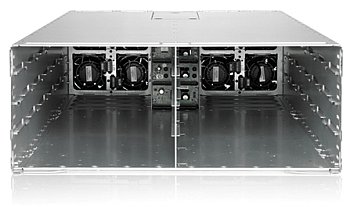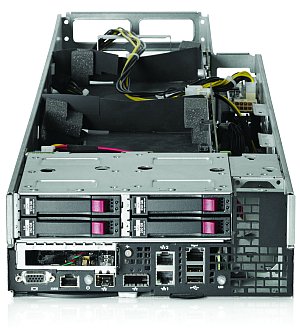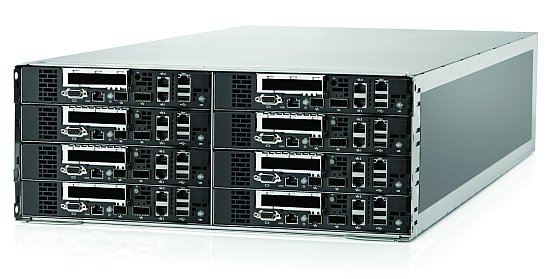CUDA and other new stuffing for ultra-scalable server systems
 Last fall, HP introduced a new family of its standard ProLiant SL6000 architecture servers . It was designed specifically to build super-scalable computing systems and provides the most dense packaging of processor power. This is primarily achieved through the use of a chassis in which power supplies and fans that are common to all server modules are located.
Last fall, HP introduced a new family of its standard ProLiant SL6000 architecture servers . It was designed specifically to build super-scalable computing systems and provides the most dense packaging of processor power. This is primarily achieved through the use of a chassis in which power supplies and fans that are common to all server modules are located.In early October, the second generation came out - the ProLiant SL6500 , which has on board the latest Intel Xeon processors and, optionally, a GPU based on the nVidia CUDA architecture. Based on the experience of using the SL6000, several changes have been implemented. The chassis height is now 4U instead of the previous 2U, the chassis supports hot swapping of server modules (and, as an option, power supplies), and the server modules themselves are equipped with hot-swappable hard drives. In addition, depending on the chassis filling, it is possible to choose power supply units for 460, 750 and 1200 W, which allows to optimize the power consumption of large server complexes.
Three models of server modules are installed in the ProLiant SL6500 chassis: ProLiant SL390s G7 , ProLiant SL170s G7 , and ProLiant SL390s G7 with the nVidia Tesla GPU installed . All of them in width occupy half the chassis, and a combination of one- and two-unit modules is allowed.
 Both versions of the ProLiant SL390s G7 — 1U and 2U high — come with the same motherboard supporting two Xeon 5600s, up to 12 DDR3 memory modules and one 10Gb and two Gigabit Ethernet ports (optionally, an InfiniBand port is supported).
Both versions of the ProLiant SL390s G7 — 1U and 2U high — come with the same motherboard supporting two Xeon 5600s, up to 12 DDR3 memory modules and one 10Gb and two Gigabit Ethernet ports (optionally, an InfiniBand port is supported).')
An additional 1U in a dual-version version of the ProLiant SL390s G7 is designed for installation from one to three Tesla M2050 or Tesla M2070 GPUs . Each GPU consists of several hundred cores, so that when using them, the speed of calculation, depending on the specific application, increases up to 36 times. In particular, the performance of supercomputer computing related to the search for oil and gas fields, research in the natural sciences, building financial models, cryptographic and other applications that are well-suited for parallelization is significantly improved. In the Linpack test, the results of which are rated 500 of the most powerful Top500 supercomputers, a system with two CPUs and two GPUs outperforms the same system without a GPU eight times.
The computational power in floating point operations of the dual-unit ProLiant SL390s with the help of the GPU can be increased to 1 Tflops. Currently, a supercomputer is created at the Tokyo Institute of Technology TiTech on the basis of a cluster of one and a half thousand ProLiant SL390s G7 with a Tesla M2050 GPU, the estimated capacity of which exceeds two petaflops. And at the American University of Georgia Tech, on the same HP platform, a petaflops supercomputer will be launched later this year.

HP ProLiant SL6500 chassis with eight ProLiant SL390s G7 single-unit modules
The third server module ProLiant SL170s G7 is similar in form factor to the single-unit ProLiant SL390s G7, but it supports not 16, but 16 memory modules. To reduce the cost, the 10-gigabit port is excluded from its configuration, and the iLO 100 is used for remote control, instead of the full-featured controller of the iLO 3 version. This model, in addition to supercomputer computing, will be used by site and application service providers.
Source: https://habr.com/ru/post/105998/
All Articles